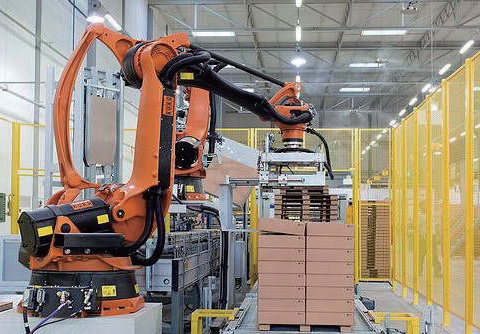





···
The development of industrial robots in China starts from the downstream industry,relying on the strong market demand, and constantly introduces and develops industrial robots suitable for our own industrial needs. The development of industrial robots in China is characterized by its late start but rapid development.
我国工业机器人的发展始于下游产业,依赖于强大的市场需求和不断地引进与开发适合我国工业需求的工业机器人。虽然我国工业机器人起步较晚,但发展很快。
Compared with the western developed countries, the research of industrial robot in China started in the late 1970s, and has roughly experienced the following five development periods: germination period (1970-1985), technology research and development period(1986-1990), prototype development period (1991-2000), preliminary industrialization period (2001-2010) and rapid development period (2011 to present).
跟西方发达国家相比,我国对工业机器人的研究始于 20 世纪 70 年代末,大致经历了以下五个发展时期。萌芽期(1970—1985 年),技术研发期(1986—1990 年),原型开发期(1991—2000 年),初步工业化期(2001—2010 年),以及快速发展期(2011 年至今)。
At present, due to the rapid development of the global economy and the fierce competition of the intelligent manufacturing industry, the demand and application of industrial robots in China begin to soar. Up to now, it has accounted for about one third of the global industrial robot market, and has become the largest industrial robot market in the world.
目前,由于全球经济的快速发展和智能制造行业的激烈竞争,中国对工业机器人的需要和应用开始飙升,已占据了全球三分之一的市场,而且已经成为全球最大的工业机器人市场。
The application fields of industrial robots in China are mainly distributed in automobile manufacturing industry, 3C electronic and electrical industry, metal processing industry,plastic and chemical products industry and many other fields. Among them, automobile manufacturing industry accounts for about 33%, 3C electronic and electrical industry accounts for about 27%, and both occupy about 60% of the market share.
我国工业机器人的应用领域主要分布在汽车制造行业、3C电子电器行业、金属加工行业、塑料化工制品行业等其他领域。在这些领域中,汽车制造行业约占 33%的市场份额,3C电子电器行业约占 27%的市场份额,两者共占据了约 60%的市场份额。
注: 3C (China Compulsory Certification) 中国强制性产品认证
···
 Look at the pictures below and match them with the proper words.
Look at the pictures below and match them with the proper words.

1

2

3

4

5

6
robotic welding
robotic material handling and packaging
robotic cutting
robotic pick and place
robotic dispensing
robotic non-destructive
inspection
①
②
③
④
⑤
⑥
 Discuss with your partner what other types of industrial robotic automation are.
Discuss with your partner what other types of industrial robotic automation are.

···



Industrial robotics is a big industry and it changes quickly. The technology as well as the volume and variety of deployments has changed dramatically in the past few decades. For those who are new to the industrial robotics industry, it may seem difficult to find a starting point.
A broad overview of the types and benefits of automation can provide a basic understanding of industrial robotics technology and the growing robotics industry.
There are many different types of automation applications that industrial robots are equipped to handle. Often, robots are designed or integrated with a specific task in mind and tailored to meet the unique needs of that task. Some common forms of industrial robotic automation include:
·Robotic welding
·Robotic material handling and packaging
·Robotic picking and placing
·Robotic dispensing
·Robotic cutting
·Robotic non-destructive inspection
While there are certainly other types of industrial robotic automation, and a myriad of other types of collaborative and service robots, the applications listed above are some of the most common industrial forms of robotic automation.
·Industrial robots have transformed the manufacturing industry for a reason. They come with many basic benefits. Their first and most important benefit is their efficiency. They complete tasks more quickly than manual labors, and their uptime is significantly higher. The combination of speed and uptime leads to higher output at lower operating costs.
·In addition, industrial robots, when programmed properly, are inherently repeatable.This improves the consistency of production dramatically, boosting overall product quality and reducing waste.
·Industrial robots typically deliver great return on investment despite high initial costs. The productivity gains from efficiency, consistency and reduced operating costs add up quickly. Part of what has made industrial robots so popular among manufacturers over the past decade.
·Industrial robots come with many basic benefits, regardless of which type of industrial robot is being implemented. As long as a robot is programmed properly and suited to fit the unique needs of a certain application, it will almost certainly outperform manual labor.
The market for industrial robots is big and growing quickly. The underlying technology changes just as fast. It can be difficult to keep up with the fast pace of change in the robotics industry, but understanding the types of industrial robots and the benefits they provide is a great start.

industrial /ɪnˈdʌstriəl/ adj. 工业的;产业的
robotics /rəʊˈbɒtɪks/ n. 机器人科学
industry /ˈɪndəstri/ n. 工业;产业
volume /ˈvɒljuːm/ n. 量;容量
variety /vəˈraɪəti/ n. 种类;品种
dramatically /drəˈmætɪkli/ adv. 显著地
overview /ˈəʊvəvjuː/ n. 概况
automation /ˌɔːtəˈmeɪʃn/ n. 自动化
application /ˌæplɪˈkeɪʃn/ n. 应用;运用
equip /ɪˈkwɪp/ vt. 配备;装备
specific /spəˈsɪfɪk/ adj. 明确的;具体的
tailor /ˈteɪlə/ vt. 专门制作;订做
unique /juˈniːk/ adj. 唯一的;独一无二的
welding /ˈweldɪŋ/ n. 焊接
material handling /məˈtɪəriəl ˈhændlɪŋ/ n. 物料运输
packaging /ˈpækɪdʒɪŋ/ n. 包装
dispensing /dɪˈspensɪŋ/ n. 分发
non-destructive /ˈnɒn dɪˈstrʌktɪv/ adj. 非破坏(性)的
inspection /ɪnˈspekʃn/ n. 审视
myriad /ˈmɪriəd/ adj. 无数的;多种的
collaborative /kəˈlæbərətɪv/ adj. 合作的;协作的
transform /trænsˈfɔːm/ vt. 使改变形态
efficiency /ɪˈfɪʃnsi/ n. 效率;效能
manual /ˈmænjuəl/ adj. 手工的;体力的
labor /ˈleɪbə/ n. 劳动;努力
uptime /ˈʌptaɪm/ n. 运行时间
output /ˈaʊtpʊt/ n. (人、机器、机构的) 产量;输出
operating /ˈɒpəreɪtɪŋ/ adj. 操作的
programme /ˈprəʊɡræm/ vt. 预设;计划;安排
inherently /ɪnˈhɪərəntli/ adv. 固有地;自身地
repeatable /rɪˈpiːtəbl/ adj. 可重复的
consistency /kənˈsɪstənsi/ n. 连贯性;一致性
manufacturer /ˌmænjuˈfæktʃərə(r)/ n. 生产者;制造者
implement /ˈɪmplɪment/ vt. 贯彻;执行
suit /sjuːt/ vt. 适合于
outperform /ˌaʊtpəˈfɔːm/ vt. 做得比……更好;胜过
underlying /ˌʌndəˈlaɪɪŋ/ adj. 根本的;基础的

as well as 也
keep up with 跟上
be integrated with 使与……结合
regardless of 不管;不顾
as long as 只要
1. Robots are designed or integrated with a specific task in mind and tailored to meet the unique needs of that task.
机器人以特定的任务来进行设计或融合并量身定制,以满足该任务的独特需要。
be tailored to 量身定制。
2. This improves the consistency of production dramatically, boosting overall product quality and reducing waste.
这大大提高了生产的一致性,提高了整体产品质量并减少了浪费。
后半句boosting和reducing是并列关系,两个动词-ing形式作前一句的伴随状语,表结果。
Fill in the blanks according to Text A.
1. How many types of industrial robotic automation are mentioned in the passage?
There are some common forms of industrial robotic automation, such as, robotic_____,robotic_____, robotic_____, robotic_____, robotic_____,robotic_______________, etc.
2. How many benefits of industrial robotic automation are mentioned in the passage?
There are four benefits.
The first and most important benefit is_______.
The second is that industrial robots, when programmed properly, are inherently_____.
The third is that industrial robots deliver great return on_______despite high initial costs.
The fourth is that as long as a robot is programmed properly and suited to fit the unique needs of a certain application, it will almost certainly_______manual labor.
 Choose the correct word to complete the following sentences.
Choose the correct word to complete the following sentences.

industrial efficiency automation specific manual consistency
1._____has helped to increase production.
2. There are many ways to increase agricultural _____in the poorer areas of the world.
3. The money is to be used for _____purposes.
4. After six years of _____labor, he was finally allowed to train as a salesman.
5. The_____Revolution first emerged ( 出现 ) in the English Midlands.
6. Their actions lack_______; they say one thing and do another.
 Choose the correct word to complete the following sentences.
Choose the correct word to complete the following sentences.
Change the form where necessary.

1.operate operation
a. We should decide as soon as possible to re-open the ______system.
b. What skills are needed to______this machinery?
2.implement implementation
a. Actually, many programs are simple to describe and______.
b. Have you finished the______section in your practice?
3. collaborate collaborative collaboration
a. We have______ on many projects over the years.
b. The government worked in close ______with teachers on the new curriculum.
c.______development is becoming a new trend.
 Match the words in Column A with the appropriate definitions in Column B.
Match the words in Column A with the appropriate definitions in Column B.

 Choose the correct phrase to complete the following sentences.Change the form where necessary.
Choose the correct phrase to complete the following sentences.Change the form where necessary.

design for as well as keep up with integrate with regardless of as long as
1. They visited some factories, hospitals______ the school.
2.______danger, he climbed the tower.
3. These tennis shoes ______comfort and performance.
4. You’re walking too fast. I can’t ______you.
5.______you are still alive, you will definitely encounter the good things in life.
6. This computer program can ______existing programs.
···


What technology has been revolutionizing manufacturing for more than 80 years? Industrial robots. It all started earlier than you think. In the late 1930s, Bill Taylor used components from a Meccano toy system to build the first pick-and-place industrial robot, known as Gargantua. The cranelike robot was programmed by paper tape and powered by a single electric motor, and it could stack blocks in preprogrammed patterns. Taylor’s design was the beginning of one of history’s most exciting industries, revolutionizing productivity in the United States manufacturing sector.
The design then reached new heights when the simple robot arms were used on the Viking 1 and Viking 2 Mars landers. They were able to easily scoop surface material and transfer it to receptacles on each lander for tests and analysis.
From the mid-1990s to the early 2000s, advancements in robotics were evolutionary rather than revolutionary. In 1994, for example, the MRC robot control system was introduced. Editable from an ordinary desktop PC, the MRC made it possible to control up to 21 axes and synchronize the motion of two robots.
But it wasn’t until after World War II that the first full-size industrial robots were produced and put to work, where they were utilized for heavy and repetitive tasks, which consisted of relatively simple motions. In 1961, a company called Unimation was established in Connecticut.Its founder—Joseph Engelberger, known as the father of robotics—led the development of the Unimate 1900-series industrial robot. It didn’t take long for the automotive industry to take note.
The next big development came when Victor Scheinman at Stanford University designed the first lightweight, all electric multi-programmable robotic arm, called the Stanford Arm. It was able to perform jobs that were unpleasant and dangerous for workers. In 1971, the creation of the first fully electrical, microprocessor-controlled robot was underway. It had an anthropomorphic structure. By 1973, 3,000 industrial robots were in use around the world, improving the way workplaces operate every day.
Over the next 10 years, robots evolved to be able to physically interact with people in a shared workspace. Known as cobots (collaborative robots), these robots could operate with limited guidance and lighten a company’s workload. By 2012, Amazon purchased the robotics company Kiva Systems, using autonomous mobile robots to automate the material handling in its warehouses. Continued innovation saw a surge in demand, and by 2014, robot sales saw a 29 percent increase worldwide, and as AI is used more and more to control robots, the demand continues to grow.
Current research into combining machine learning with robotics is exploring how industrial robots can train themselves to perform complex tasks and adapt to their surroundings. The robot’s ability to solve problems independently has the potential to change manufacturing industries as we know them. Today, the automobile industry remains the heaviest user of industrial robots, with electronics manufacturing in second place and chemicals and plastic production in third. The Unimate robot remains one of the most significant contributions to manufacturing in the past 100 years. The question now is, which industry will robotics innovate next? Only time will tell.

revolutionize /ˌrevəˈluːʃənaɪz/ vt. 使彻底变革
component /kəmˈpəʊnənt/ n. 组成部分
cranelike /kreɪnlaɪk/ adj. 像起重机一样的
stack /stæk/ v. 放成整齐的一叠
block /blɒk/ n. 大块
preprogrammed /ˈpriːˈprəʊɡræmd/ adj. 预编程的
sector /ˈsektə/ n. 部门;领域
lander /ˈlændə/ n. 着陆器
scoop /skuːp/ n. 铲子
surface /ˈsɜːfɪs/ n. 表面
receptacle /rɪˈseptəkl/ n. 容器
analysis /əˈnæləsɪs/ n. 分析;分析结果
World War II 第二次世界大战
full-size /ful saɪz/ adj. 全尺寸的
utilize /ˈjuːtəlaɪz/ vt. 利用;使用
establish /ɪˈstæblɪʃ/ vt. 建立;确立
series /ˈsɪəriːz/ n. 一系列
lightweight /ˈlaɪtweɪt/ adj. 轻量的
multi-programmable /'mʌltiˈprəʊɡræməbl/ adj. 多重程序控制的
underway /ˌʌndəˈweɪ/ adj. 进行中的
anthropomorphic /ˌænθrəpəˈmɔːfɪk/ adj. 拟人化的
advancement /ədˈvɑːnsmənt/ n. 发展;前进
evolutionary /ˌiːvəˈluːʃənri/ adj. 进化的;演变的
revolutionary /ˌrevəˈluːʃənəri/ adj. 革命的;巨变的
introduce /ˌɪntrəˈdjuːs/ vt. 引入
editable /ˈedɪtəbl/ adj. 可编辑的
axe /ˈæks/ n. 轴
synchronize /ˈsɪŋkrənaɪz/ v. (使)同步
motion /ˈməʊʃn/ n. 运动
evolve /iˈvɒlv/ v. 进化;逐渐形成
physically /ˈfɪzɪkli/ adv. 身体上
shared /ʃeəd/ adj. 分享的
cobot /ˈkəʊbɒt/ n. 协作机器人
workload /ˈwɜːkləʊd/ n. 工作量
autonomous /ɔːˈtɒnəməs/ adj. 自主的
automate /ˈɔːtəmeɪt/ v. (使)自动化
handling /ˈhændlɪŋ/ n. 运输;处理
warehouse /ˈweəhaʊs/ n. 仓库
innovation /ˌɪnəˈveɪʃn/ n. 改革;创新
surge /sɜːdʒ/ n. 激增
demand /dɪˈmɑːnd/ n. 需求
AI (Artificial Intellegence) 人工智能
current /ˈkʌrənt/ adj. 当前的;现在的
complex /ˈkɒmpleks/ adj. 复杂的;难懂的
potential /pəˈtenʃl/ n. 潜在性;可能性
automobile /ˈɔːtəməbiːl/ n. 汽车
electronics /ɪˌlekˈtrɒnɪks/ n. 电子学
chemical /ˈkemɪkl/ n. 化学
significant /sɪɡˈnɪfɪkənt/ adj. 显著的
innovate /ˈɪnəveɪt/ v. 创新;改革

adapt to 适应
be known as 被认为是
transfer to 转移到
put to work 投入使用
rather than 而不是
interact with 跟……互动
in second place 其次
1. It wasn’t until after World War II that the first full-size industrial robots were produced and put to work, where they were utilized for heavy and repetitive tasks, which consisted of relatively simple motions.
直到第二次世界大战后,第一批全尺寸的工业机器人才被制造出来,并投入使用。他们被用于做一些繁重和重复性的工作。这些工作只需要机器人简单的动作就能完成。
It was... that... 是强调句,这里强调时间。 where 是关系副词,引导定语从句,在定语从句中作地 点状语,在这里指机器人工作的领域; which 是关系代词,也引导定语从句,在定语从句中作主语, 指代前面一句的 tasks。
2. Current research into combining machine learning with robotics is exploring how industrial robots can train themselves to perform complex tasks and adapt to their surroundings.
目前把机器学习和机器人结合起来的研究正在探索工业机器人是如何训练自己去做更复杂的工作,并适应周遭的环境。
本句真正的主语是 current research, 谓语动词是 explore, 此处用的是现在进行时。
Read Text B and decide whether the following statements are true (T) or false (F).
______1. The first pick-and-place industrial robot was built by Bill Taylor in the 1920s.
______2. The first full-sized robots were produced and began to work after the World War II.
______3. Victor Scheinman designed the first robot, called the Stanford Arm.
______4. Robots evolved to be able to physically interact with people in a shared workspace.
______5. Today, the chemical industry is the heaviest user of industrial robots.
 Choose the correct word to complete the following sentences.
Choose the correct word to complete the following sentences.
revolutionize surface establish workload warehouse potential
1. A fire had severely damaged the_____.
2. They just didn't have enough people to manage the_____.
3. This product is going to_____transportation forever.
4. The two countries have______close relations.
5. The coronavirus can survive on some_____.
6. She has great_____as an artist.
 Choose the correct word to complete the following sentences.
Choose the correct word to complete the following sentences.
Change the form where necessary.
1.utilize utilization
a. Computer has found an increasingly wide______in all fields
b. Sound engineers______a range of techniques to enhance the quality of the recordings.
2.advance advancement
a. Our knowledge of the disease has______considerably over recent years.
b. Thinking is the flower of an era while new mode of thinking is the pioneer of historical______.
3. signify significant significance
a. The potential benefits of this approach are______.
b. She couldn’t grasp the full______of what he had said.
c. This sound and fury, however, may______something important.
 Match the words in Column A with the appropriate definitions in Column B.
Match the words in Column A with the appropriate definitions in Column B.

 Choose the correct phrase to complete the following sentences. Change the form where necessary.
Choose the correct phrase to complete the following sentences. Change the form where necessary.
be known as transfer to put to work rather than interact with adapt to
1. Our company will______London.
2. The old machine was fixed up and______again.
3. Manchester______the gateway to the north.
4. The company can easily______changing demand.
5. Partners must______each other’s ideas.
6. It would be better to transport the goods by rail ______by road.
···
 A.
In English, the suffix
-ion
can be added to some verbs to form nouns, meaning“action or
condition of...”.
A.
In English, the suffix
-ion
can be added to some verbs to form nouns, meaning“action or
condition of...”.
在英语中,后缀 -ion 可以加在一些动词之后构成名词,意为“……的动作或状态”。
confess ( v. )+ -ion → confession ( n. )
hesitate ( v. )+ -ion → hesitation ( n. )
Write out the nouns derived from the following verbs and fill in the blanks in the sentences below with them. (写出由下列动词派生出的名词,并根据句意填写相关的词语。)

1. Now he is working in_____.
2. There’s still_____about the number of students.
3. India’s myths and songs are the _____for her books.
4. Over the years, I’ve come to the _____that she’s a very great musician.
5. His proposals were met with_____.
6. The whole of _____is made up of energy.
7. Nowadays, the job _____is so fierce.
8. She tried to find the _____of that problem.
 B.
In English, the suffix
-ment
can be added to some verbs to form nouns, meaning“result or
means of…”.
B.
In English, the suffix
-ment
can be added to some verbs to form nouns, meaning“result or
means of…”.
在英语中,后缀 -ment 可以加在一些动词之后构成名词,意为“……的结果或手段”。
state ( v. )+ -ment → statement ( n. )
argue ( v. )+ -ment → argument ( n. )
Write out the nouns derived from the following verbs and fill in the blanks in the sentences below with them. (写出由下列动词派生出的名词,并根据句意填写相关的词语。)


1. I saw an_____of new cell-phone in the local newspaper.
2. My major in university is Hotel_____.
3. Our country’s economic_____is so fast.
4. The judge kept nodding in_____.
5. He stopped and watched with_____to see the child so absorbed.
6. There was_____behind the window in the back door.
7. She was unable to find_____.
8. I am so sorry that your_____of the film was spoiled.